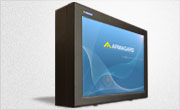The Future of Flat Panel TVs
Posted by: Richard Williams | Posted on: | 0 Comments
LCD televisions have been around for several years. With their continuing falling price, clarity of image and relatively low energy requirements has meant LCDs have become the ubiquitous television of choice for both home use and digital signage. LCDs have now easily overtaken plasma in both these sectors, and with larger and larger LCD sizes now available, they no longer seem to have any limitations.
And the technology is not standing still. LCD televisions are continuing to evolve with the next generation of screens aiming for even better picture quality and lower energy use.
Rise of LED Screens
The biggest source of power for an LCD TV is the backlight. Unlike plasmas and CRT screens (cathode ray tubes—remember them?) which generate their own brightness, LCD televisions require a lighting system to project the image. Traditionally, LCD backlights have been fluorescent tubes, similar to those used in strip lighting. The drawback to these systems is not only in the power usage required to project the screen images, but also that the tubes eventually fade and burn out, leaving the screen to lose its brightness. This type of backlight system also generates a lot of heat, which results in LCDs requiring extra cooling fans when installed in digital signage enclosures.
Many of the next generation LCD screens, however, are LED backlit systems. LEDs (light emitting diodes) require far less power than conventional backlight systems and yet generate just as much light. Furthermore, LEDs produce less heat and are longer lasting meaning the screen lasts longer.
Next Generation of High Definition
Most LCD screens on the market now take advantage of HD technology (High Definition). High Definition has five times as many pixels per frame as standard television images, which makes for a clearer, sharper image. However, recent advances in technology has meant that HD is now being superseded with the next generation of televisions that boast UltraHD (UHD)
UHD has 16 times the resolution of HD making images incredibly vivid and clear, and if the speed at which HD technology replaced standard screen quality is anything to go by, in the next few years, UHD will probably become as ubiquitous too.
Post shortlink:
Popular Products
LCD Enclosure
Need armor for your LCD/LED screen(s)? Outdoors or inside the versatile LCD enclosure protects against thieves, vandals & the weather. Installation idea: NFL stadiums.
Outdoor Digital Signage
Exclusive 46” outdoor screen protection. Dubbed the ‘Totem’, due to its distinct design, it repels damage threats, but attracts audiences. Installation idea: Drive-thru restaurants.
Portrait Flat Panel Enclosure
Safeguard your eye-level advertising display screen(s), indoors or outdoors. Completely customizable, add exciting features like touch screen technology. Installation idea: Restaurant frontages.
Indoor Digital Signage
Popular purchase for retail outlets! Great for ‘point of sale’ persuasion, boost your brand with static & motion advertising from a single unit! Installation idea: Mall of America.




